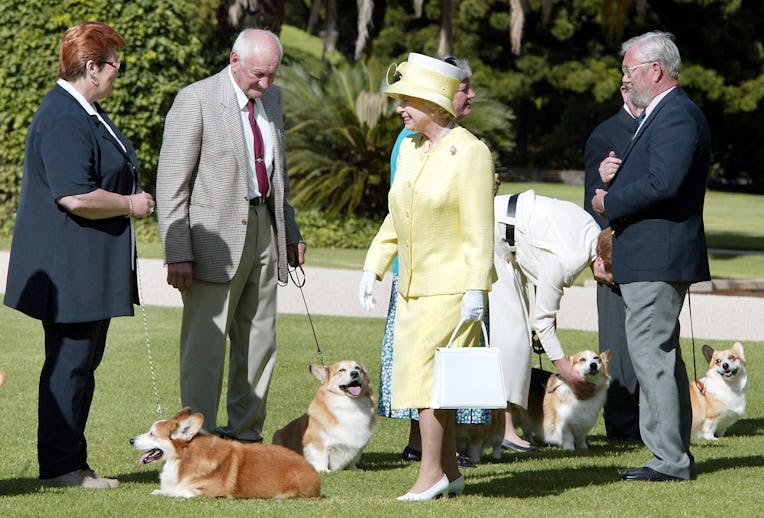Remembering the Queen's Fallen Corgis
Rest in Peace, Susan

The Queen is officially dead. We wish her the best, but no one gets out of here alive. She leaves behind her large, constantly fighting family and the memory of the 30-odd dogs, mostly corgis or corgi-adjacent mixes, that she bred over the course of five decades in power — all but a handful of whom are also dead.
That was, to some degree, Liz’s plan: She stopped breeding corgis in 2018 because she reportedly didn’t “want to leave any behind.” (The Palace denied this at the time, telling reporters: “The corgis are a private matter.”) But some of those pooches were taken too soon — or tried to take others too soon in a violent way — which is why the Wikipedia page for the royal corgis has a subsection titled: “Victims.”
First, some background: Her Maj got hooked on corgis in 1933, when her father brought home a Pembroke Welsh Corgi, whom they named “Rozavel Golden Eagle.” They wound up calling him “Dookie,” not after the Green Day album, which wouldn’t come out for over 60 years, but because it sounds like the Duke of York. One thing led to another, and soon the royal family had Crackers the corgi, then Jane the corgi, and finally, on Liz’s 18th birthday, a fourth corgi all her own. They initially named No. 4 “Hickathrift Pippa,” before settling on the obvious nickname, “Sue,” which in turn evolved into “Susan.”
Susan was the Queen’s “foundation bitch” — some dog lingo meaning that every subsequent corgi the Queen owned has been Sue’s descendant. She was also an actual bitch, according to a 1959 Calgary Herald article headlined “Queen’s Dog Spots Man, Zip —Teeth in Pants.” It detailed an incident in which Sue “sank her sharp teeth into the pants of a young policeman patrolling the royal family’s fences.” This was a repeat offense; she’d already bitten, swear to god, “a sentry, a detective, and the royal clock winder.” It became a big enough problem that when one of the corgis bit a postman in 1968, he requested the Queen hang “Beware of the Dog” signs around Balmoral.
Liz knew all this, but somehow still thought, “I need more.” She started to breed corgis in the 1950s, and never sold any of them (though she did give some away as gifts). As a result, Sue now has an extensive family tree — a list that includes the names “Windsor Loyal Subject,” “Windsor Quiz,” and “Myth.” The BBC put together a chart to help track her progeny.
The Queen’s corgis lived better than most Brits; they had the full run of Buckingham Palace, plus the other castles, including a “special corgi room,” where they had “wicker baskets lined with cushions to keep the draughts aways,” according to royals author Penny Junor.
But the luxe pad and chef-made food occasionally went to the hounds’ heads, judging from the various times they killed or gored one another. In 1989, for example, Liz’s dog Ranger “led a pack of corgis that killed [another dog named] Chipper,” according to the New Zealand Daily Herald. They hated Chipper because he was different; he was a “dorgi,” or a corgi-dachshund mix, and reportedly “the Queen’s favorite.” Specifics about the massacre were sparse because the royals once again demurred on the details. “It would be a private matter,” the Palace told press at the time.
A few years later, in 1991, the pack broke out into another fight, according to the Toledo Blade. The melée involved some 10 dogs total, two of which belonged to the Queen Mother. In the chaos, the Queen got bitten and wound up with three stitches on her left hand. The Queen Mum’s chauffeur was also wounded; he needed a tetanus shot.
Then in 2003, a dog named Pharos, Susan’s 10th-generation descendant, had to be put down after an alleged mauling from Princess Anne’s bull terrier, Dottie. “Dottie went for Pharos — savaging the corgi's hind legs and breaking one in three places,” one report read. “Growls and yelps were heard through the corridors as the attack went on.” Pharos was put in “intensive care,” but didn’t make it. Princess Anne was forced to plead guilty to a criminal charge under the U.K.’s “Dangerous Dog Act.” She paid a £500 fine.
The good news is that, now that Lilibet has lost her own metaphysical dogfight, she has been reunited with Pharo and her other fallen soldiers in the great doghouse in the sky. The bad news is she has left at least three dogs behind, including a 13-year-old dorgi named Candy, a corgi named Muick, and an unidentified puppy she bought to replace Fergus, her dorgi puppy who died last year. It’s unclear what they will do in the wake of their owner’s passing, but if history is any indicator, King Charles III should watch his ankles.